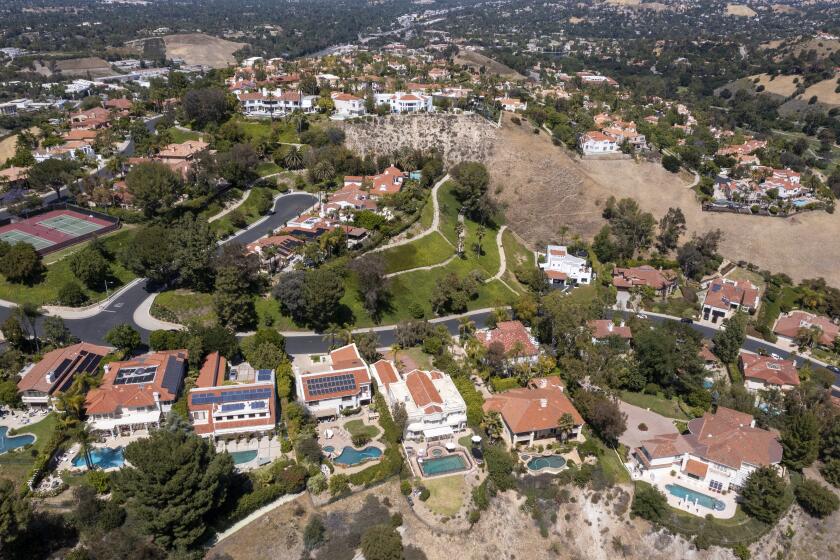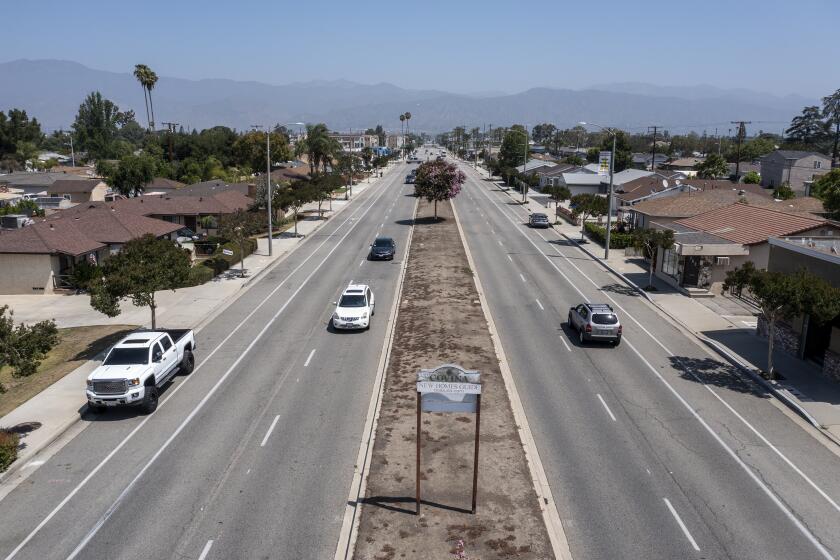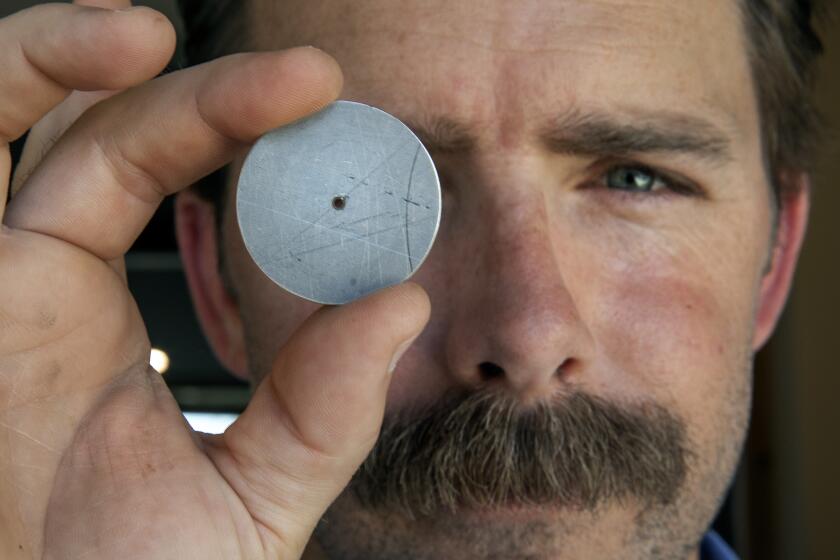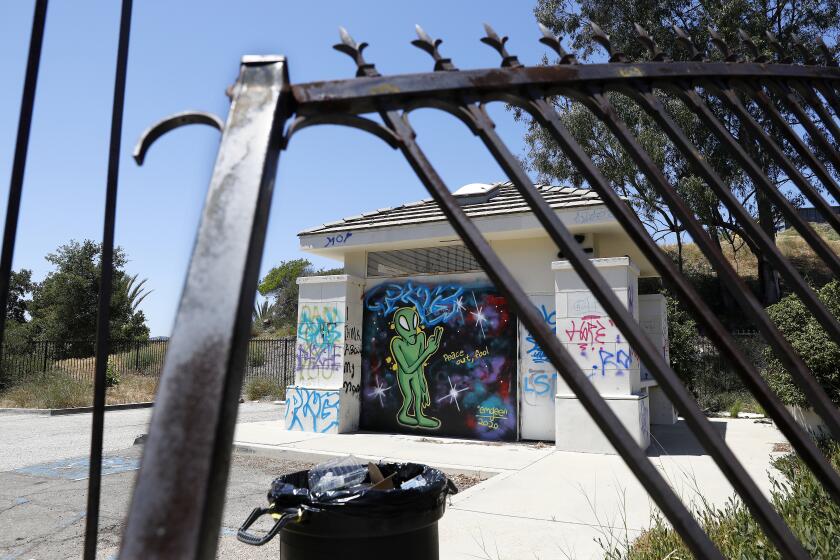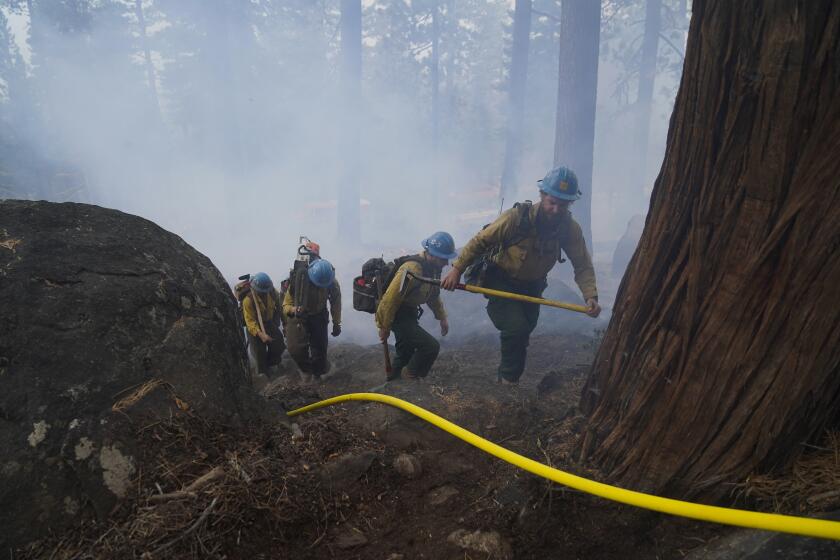L.A. needs 90,000 trees to battle extreme heat. Will residents step up to plant them?
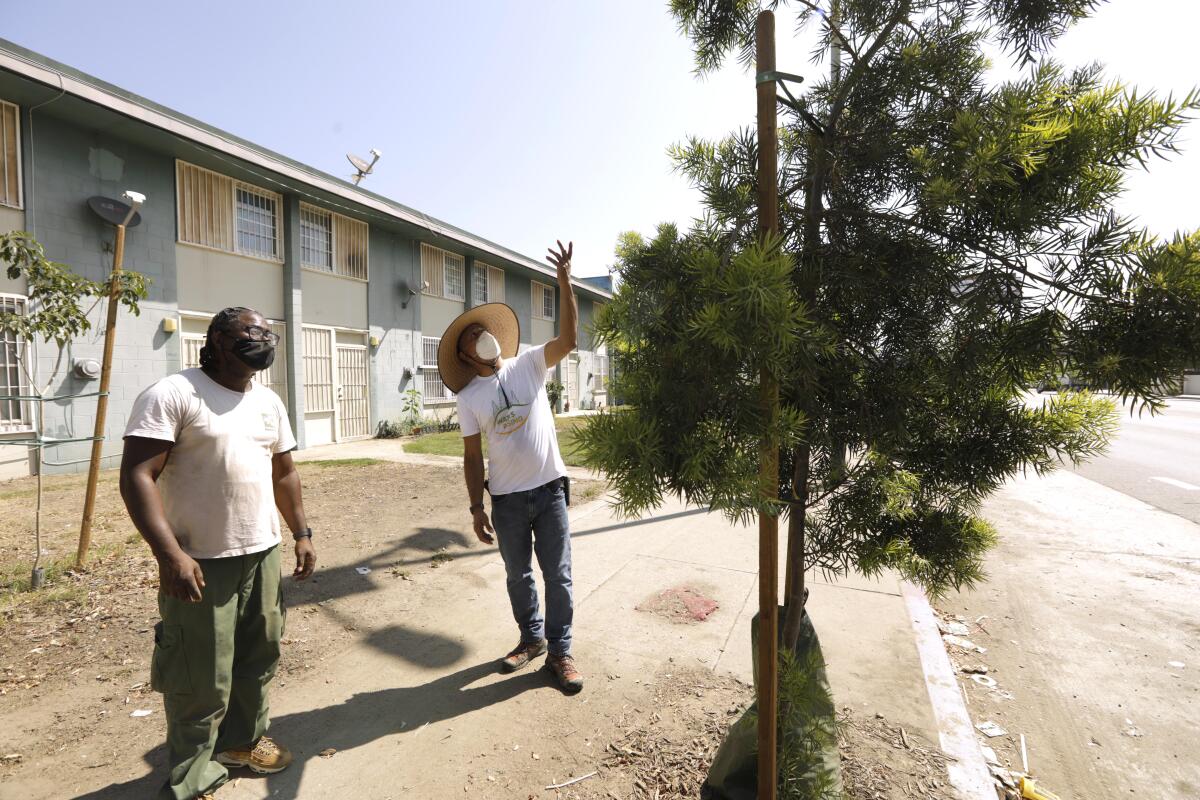
- Share via
In 2019, Mayor Eric Garcetti unveiled an ambitious plan to plant 90,000 trees in Los Angeles by 2021 as part of L.A.’s Green New Deal.
To accomplish this, he appointed the city’s first forest officer, Rachel Malarich, to head the Urban Forestry Division. The city also authorized a network of non-profits and “community ambassadors” to aid and encourage residents in planting much-needed trees.
But more than a year after Garcetti’s deadline, it turns out that planting trees in Los Angeles is a lot more difficult than it sounds — particularly when it comes to targeting those neighborhoods most in need of the temperature-reducing and air- cleaning benefits trees provide. To date, just over 65,000 trees have been planted.
Now, as global warming and extreme heat increase health risks for people who live in areas with little to no tree cover, Los Angeles officials are finding that their reliance on city residents to plant and care for the trees comes with significant limitations: Residents in poorer neighborhoods who don’t own land can find it difficult to actually plant trees, or they can encounter difficulty caring for a new trees during their critical three-year establishment phase.
In some areas — such as canopy barren downtown — new trees are often destroyed by vehicles or vandals before they can mature, while older trees are cut down by developers of new buildings, or transportation crews seeking to clear sightlines at intersections.
Water agencies and officials are working to get the message out on the importance of trees and keeping them alive during the drought.
But this isn’t the first time L.A. has launched a grand-scale tree planting campaign that has run into significant hurdles. In 2006, Los Angeles Mayor Antonio Villaraigosa launched a program to plant 1 million trees, along with New York City and Shanghai. But by April 2013, the city had planted a little more than 400,000.
This time around, Malarich said she’s more concerned about the equity aspect of trees and where they’re being planted rather than the number. She noted that Garcetti’s pledge included a promise to boost city tree canopy by at least 50% in low-income areas by 2028.
“The amount of protections we’re providing through increased canopy cover is more important than the number of trees,” Malarich said.
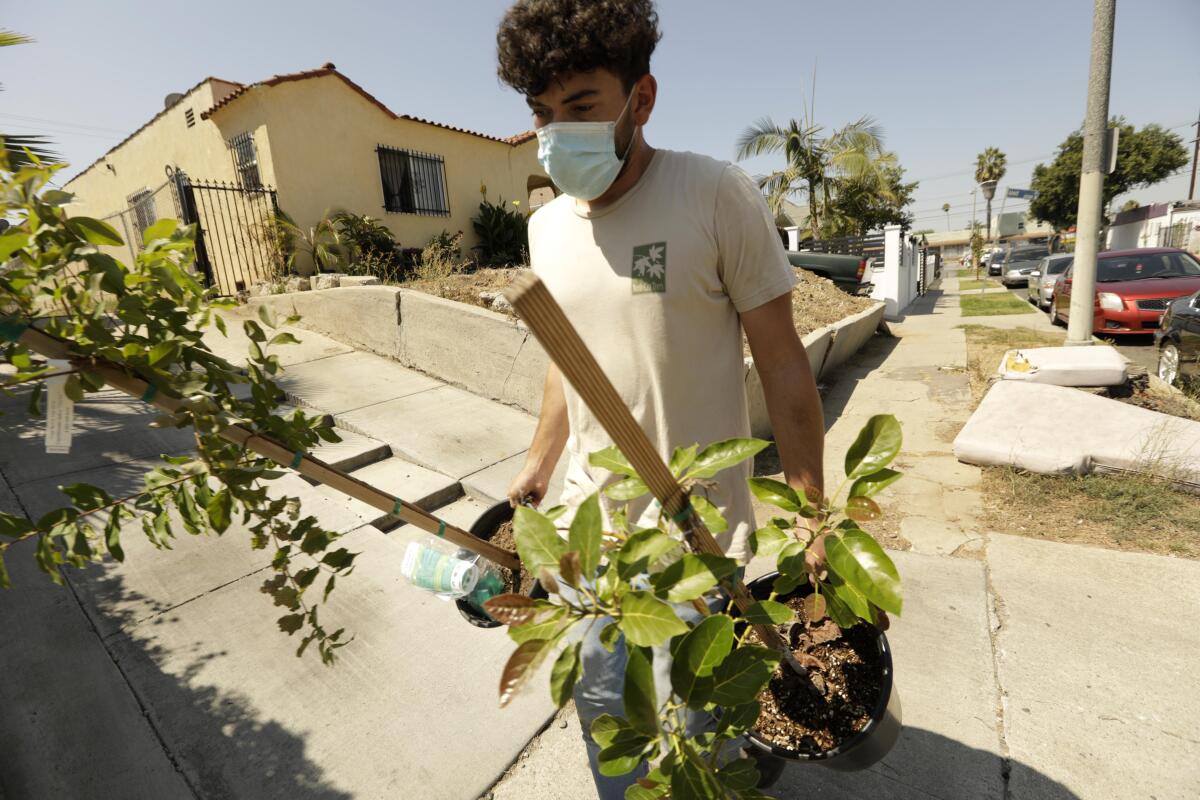
Trees provide myriad benefits to Angelenos, including capturing storm water runoff and replenishing groundwater, cleaning the air and improving mental health. Researchers have also found that neighborhoods with few trees and a lot of pavement, large buildings and other heat-absorbing surfaces can be 10 degrees warmer than surrounding areas.
Even with historic drought restrictions, experts have stressed the importance of continuing to water trees and keeping them alive. During the last drought, as many as 14,000 trees in L.A. parks — about 4% of the total — may have died.
The drought restrictions implemented June 1 by the L.A. Department of Water and Power include an exception for the hand-watering of trees, however, and should not have an adverse effect on tree health if they are followed correctly, experts said.
More than 6 million Southern Californians will be placed under new drought rules today in an unprecedented effort to conserve water.
In an effort to increase the city’s tree canopy, officials have contracted with a nonprofit called City Plants, which works with other community organizations and nonprofits to get trees planted and cared for.
The city itself doesn’t do much planting directly. An estimated 90% of L.A.’s urban forest is on private property, and even street trees are often under the care of the residents who live nearby.
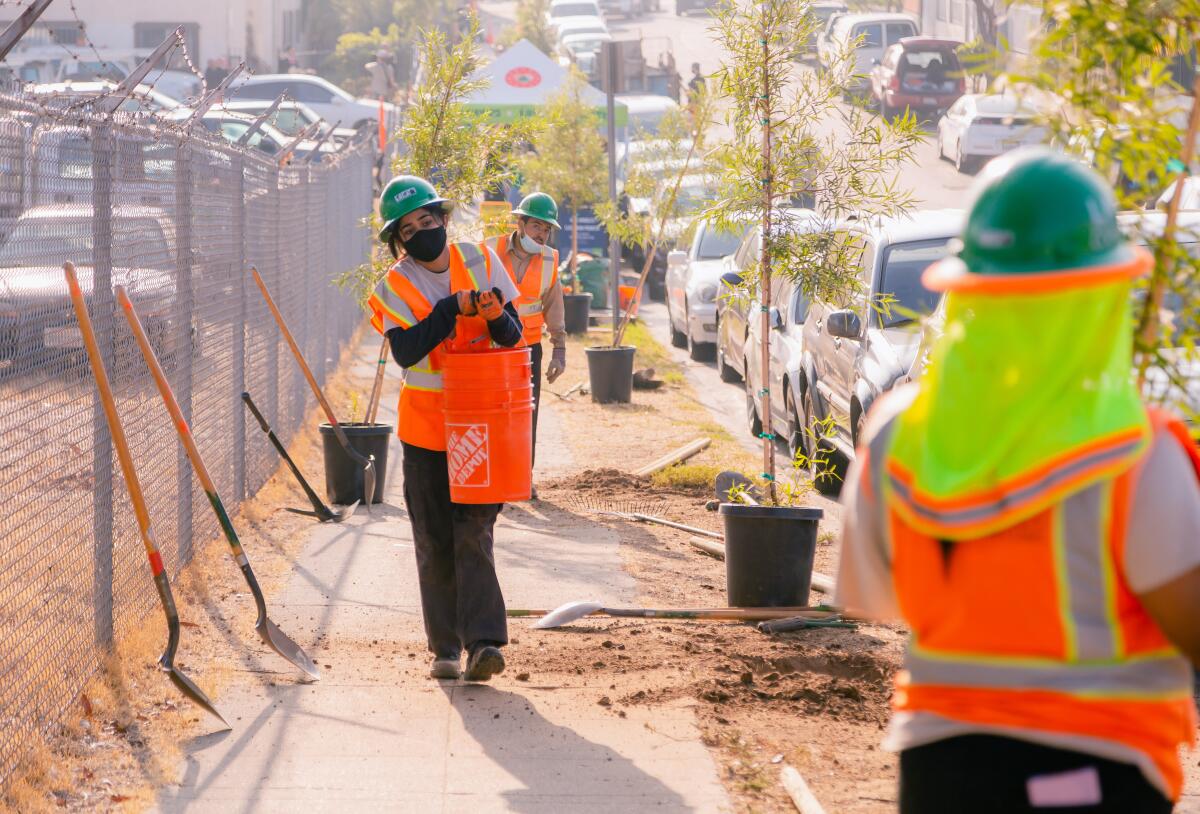
Under the current campaign, City Plants will give seven free trees to any L.A. resident to plant in their yard — a service funded by the Department of Water and Power. The trees are delivered to homes, along with stakes, ties and fertilizer pellets. City Plants tracks planting locations and monitors the trees’ survival for three years — the most vulnerable period of a young tree’s life.
Residents can also request a street tree — one planted in the public right of way — but must sign a Commitment to Water form promising to care for the tree for the first three to five years of its life, which means a deep watering of 10-15 gallons of water once a week by hose or bucket. After the three-year mark, the trees become the responsibility of the Urban Forestry Division.
In some cases, money from City Plants and state grants from the California Department of Forestry and Fire Protection are able to fund the establishment care for the tree — which includes watering, adjusting stakes and ties and anything else needed to ensure survival in the first three years.
The city also created a Tree Ambassador program last year to develop leaders in historically disadvantaged neighborhoods and assist them in planting and caring for trees in their communities. The inaugural cohort began in September 2021 and ended this April with about 400 trees planted.
The ambassadors serve as community liaisons to help find residents who are interested in planting trees and communicate the importance of caring for neighborhood trees.
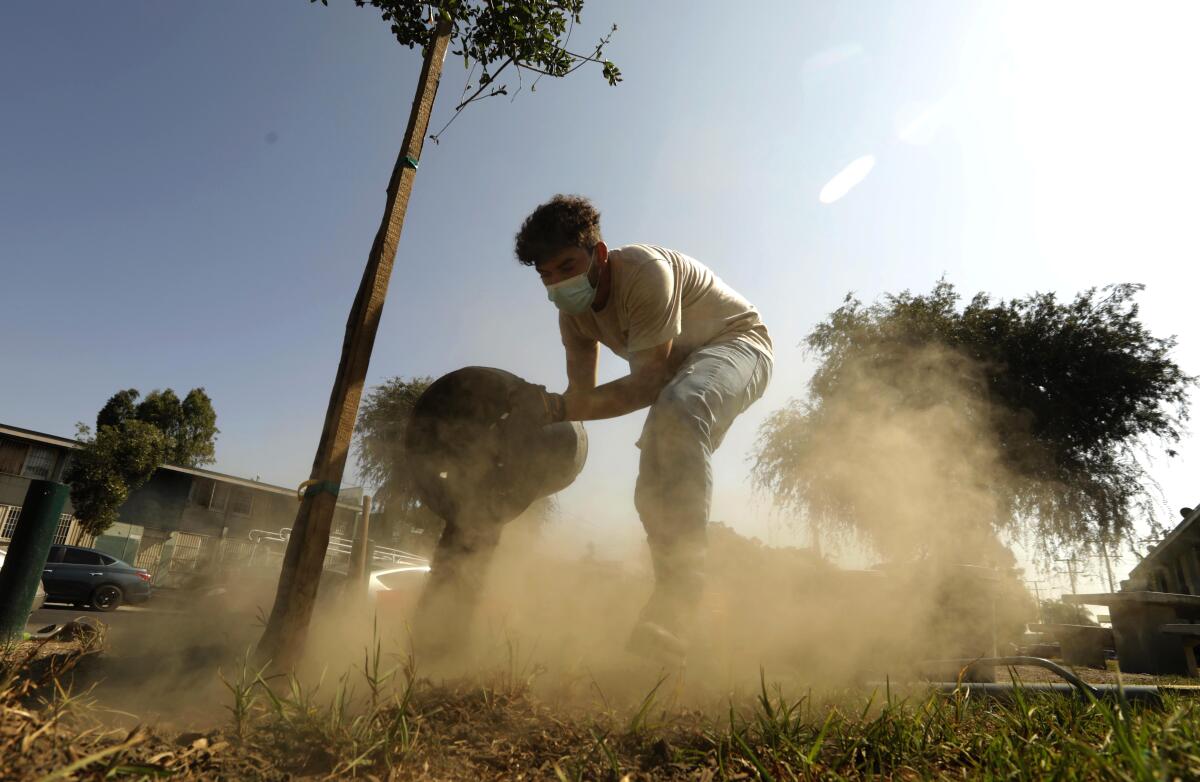
“The way we structured that program is really to amplify local leader voices,” said City Plants executive director Rachel O’Leary. “And many of those local leaders living in neighborhoods that were historically disinvested — wanting to really, honestly, directly compensate them for their community organizing.”
It’s a model that not everyone agrees with however.
“They’re leaning on nonprofits to get there, they’re leaning on homeowners to get to that goal [of 90,000 trees],” said Katherine McNenny, co-founder of Industrial District Green, a nonprofit focused on tree planting downtown. “That’s cheating.”
Giving out trees benefits homeowners who live in areas that might not need more trees, rather than a renter in a low-canopy area, especially with the three-year watering commitment, McNenny said.
“Someone in a low-income community who got a free tree from the city of L.A. a block away … how are they gonna water those trees?” McNenny said.
Though McNenny appreciates the work done by nonprofits, she believes the city itself needs to be doing more direct planting and watering by city employees.
In one wealthy Los Angeles County enclave, 70% of water is used outdoors. Officials hope to curb chronic overuse with these custom flow restrictors.
On a recent sunny Saturday morning that quickly rose to sweltering temperatures, tree ambassador Cristina Velazquez sat at a green table in Koreatown next to buckets of tree saplings.
Curious locals stopped by to ask — are you really giving away trees for free? How can I get one?
Though most of the trees were reserved for pickup, some were available for same-day adoption — coast live oaks, Canary Island pines, a crape myrtle with showy summer flowers. Velazquez warned some people to carefully consider how much room they had in their yards, because the oaks would get large.
“It is a new member of your family,” Cristina Basurto, senior community engagement coordinator for the Koreatown Youth and Community Center, told people who came to take their trees home. “When you talk to them, they thrive even more.”
Many people were first-time tree planters and keen on making sure their trees survived. Mulch is good, Basurto advised, but she warned folks against making “mulch volcanoes” around the base of the tree because they can foster too much moisture and cause bark rot. Pomegranates are multi-trunk trees and do particularly well with other pomegranates nearby. And guavas, well you’ll have to fight with the squirrels and birds for them.
Some of the people who came to pick up trees were homeowners, though a few were renters who obtained permission from their landlords or lived in a building with a dedicated gardener.
City Plants has been holding various tree adoption events around the city, partnering with organizations like the KYCC, Los Angeles Conservation Corps and TreePeople.
“A lot of the open space we have available isn’t in the sidewalks; it is in their homes,” Basurto said.
After years of complaints, lockouts and delinquent taxes, coastal authorities have fined a developer for failing to maintain a trailhead facility.
While there’s always talk of funding for the trees themselves, what’s often neglected is money for establishment care, which is why community buy-in is so important, Malarich said.
One of the partners for the Tree Ambassador program is long-established environmental advocacy group TreePeople, which has its own 30-year-old Community Forester Program. Its model also focuses on empowering volunteers to lead tree-planting events in their own communities.
A federal firefighter’s viral resignation letter is highlighting the job’s low pay and harsh working conditions in the age of climate change.
TreePeople currently has a grant to plant 1,000 trees exclusively in the Watts neighborhood and distribute thousands more trees for schools and yards, said Ariel Lew Ai Le Whitson, director of education and community. It’s applying for another grant to plant 4,000 trees in South L.A.
Not everyone is always excited about getting a tree planted in their neighborhood, however. When walking on the sidewalks of L.A., it’s easy to see some of the infrastructure damage caused by trees.
“A resident might have some feelings because a tree was planted there many years ago and maybe messed up their sidewalk,” said Eileen Garcia, senior manager of community forestry.
As tree planting efforts continue, City Plants emphasizes its philosophy of “right tree, right place, right reason” to ensure trees aren’t causing further damage in the communities they’re placed in, executive director O’Leary said.
This issue is exacerbated in historically disadvantaged low canopy areas, where you often see parkways that are too narrow for trees, or trees growing in the public right of way.
While some of the promises made during the previous drought have been kept, conservation efforts are slipping as well-drilling threatens groundwater.
Garcia said she hopes to see more funding for more drastic actions such as tearing up large stretches of concrete to create new locations for trees.
The city is currently undergoing a massive tree inventory of street trees and vacant spots, covering 500 square miles, Malarich said. An arborist will visit every tree in the public right of way and record the species, age and size of the tree. Officials hope to complete the study by next summer, and estimate they will count more than 700,000 trees. The city does not however track the mortality rate of young, newly planted trees.
Malarich is also overseeing an update of the recommended street tree species list, which has to take into account infrastructure and spacing, climate, and the wide range of soil types that can be found around the city.
But it all comes back to what’s important to the community.
“That’s part of what’s so complex — we have our expert opinion based on science and data related to tree species but we also have a living piece of infrastructure that people have a strong opinion about,” Malarich said.
